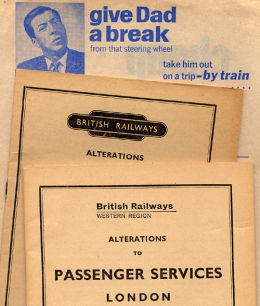Posted 7th October 2009
1964

1964 was the first full year in which the recommendations of the 1963 Beeching Report started to come into effect. 1595km of route was closed (49km of this had been used only by freight trains). 571 stations were closed to passengers, but almost 1800 freight yards were taken out of use. Another 2075 steam locomotives were scrapped, and 408 diesels either built (221) or bought (187). 4996 locomotive-hauled coaches were also withdrawn, representing almost a quarter of the stock at the start of the year. 1182 of the withdrawn coaches were compartment vehicles without corridors built for local or suburban services, which had been made redundant by the closure of lines or replaced by multiple units.
The withdrawal of steam locomotives meant that large areas were now almost entirely worked by diesels, including most of the West Country and many of the non-electrified main routes elsewhere. Steam was also virtually withdrawn from the Central Section of the Southern Region by the end of 1964, although it would continue on the Bournemouth line for several more years.
So modernisation was continuing, and the economies of this (plus closures) helped to reduce the British Railways Board working deficit by £14.8m to £67.5m. Passenger and freight kilometres rose by 3.6%, but there were fewer passenger journeys: 927.6m compared wirh 938.4m in 1963. Reorganisation continued at management level, transferring some of the former responsibilities of the Regions to the Board HQ in London.
The experimental XP64 rake of coaches entered service, making its first demonstration run between London Marylebone and High Wycombe in May. The first 70 Mk2 coaches were completed: they would be the first of a much larger fleet in the years to follow, which would be developed to include an air-conditioned version. Design work also began on 29 Pullman locomotive-hauled coaches, which were modelled on the Blue Pullman sets but would run on improved B4 bogies.
The political landscape was made more complex by a General Election in October, which ended the 13-year reign of the Conservatives. The new Labour government, led by Harold Wilson, had a majority of just four seats. The Labour manifesto had spoken of new regional authorities, which would ‘be asked to draw up transport plans for their own areas. While these are being prepared, major rail closures will be halted’ , but in practice most of BR's withdrawal proposals continued to be approved after Labour had come to power.
---------------------------------------------------------
At the start of 1964, BR had:
4145 passenger stations
20 323km of passenger/freight lines
7001km of freight-only lines
7050 steam locomotives
4060 diesel locomotives
194 electric locomotives
4132 dmu vehicles
6997 emu vehicles
20 469 hauled passenger vehicles
(Source: BRB Annual Report)
----------------------------------------------------------
Other changes in 1964 included the first signs of a new corporate identity for British Railways, which was sponsored and encouraged by Doctor Beeching. The XP64 set was painted in a new blue livery, while the BR totem, introduced in 1948, made its last appearance on printed matter during the year, although metal versions would linger at some stations for almost another two decades. The totem was progressively replaced by nondescript alternatives on new publicity during 1964, until the ‘double arrow‘ and the new name ‘British Rail’ could be formally launched in early 1965.
One more change involved the basic matter of time: from 1964 BR timetables began to use the 24-hour clock.
